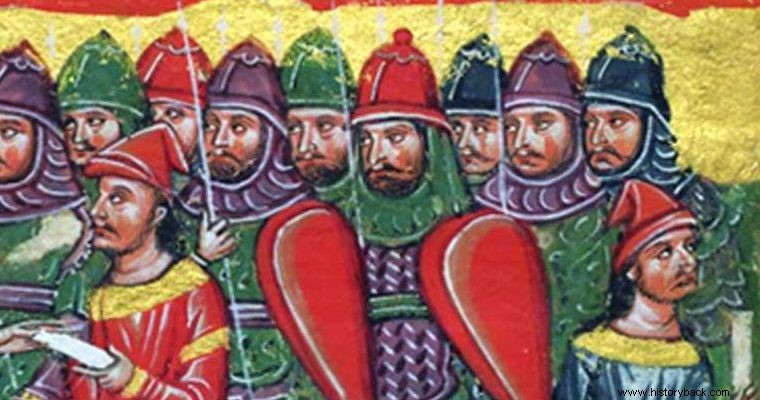
The Byzantine Empire survived over 1000 years with its powerful army as its support. An important power multiplier of the Imperial armies was the well-trained heavy infantry, the famous Scutati (shield-bearing, from the Latin word scutum =shield) infantry.
The Skutatoi, in that period, were organized in battalions or bands, with a strength of 200-400 men. Of these, 256 were combatants. The organizational model of the Byzantine heavy infantry followed Macedonian standards. Thus each battalion numbered 256 fighting men, exactly as many as the regiments of Alexander the Great, arranged in 16 lines, with a depth of four to eight scales.
However, the battalions of the Scoutas did not include in their ranks exclusively heavily armed infantry. In any case at least ¼ of the men of the heavy infantry battalion were armed with bows. The archers gave the Byzantine Scoutatus the firepower that the ancient Greek hoplites lacked. This formation was a development of the experimental phalanx of M. Alexander, within which sarissaphoros and archers were lined up.
The archers always took position behind the yokes of the Scoutas and supported them with overhead shots. But it was possible for the archers to "join" between the yokes of the Scoutas and in this way shoot directly at the opponent, protected by the large shields of their colleagues. A similar tactic was used by the Mycenaean archers, based on the Homeric description.
This practice was of course called "Entaxis", while the practice of lining up the archers behind the Scoutatus was called "Epitaxis". A third formation of the heavy battalions was the famous "Fulcon". In essence, this formation was also the ancient Greek formation of the "Coalition", i.e. the creation of a continuous wall of shields and spearheads. This formation was mainly used when the battalion received a cavalry charge.
With the lines of infantry thickening and the presentation of a forest of lances, the momentum of even the most heavily armored cavalry was sure to be halted. In case of need, the infantry formed a "porcupine", a formation similar to the Fulcon, which, however, ensured all-round defense, like the Napoleonic squares.
Until the time of Heraklion, approximately, the Scythians fought based on the Roman way of fighting. The short spears they had could also be used as javelins. The emperor Maurice himself, in the "Strategikon", advises infantrymen to throw their light spears at enemy infantry attacking them, just before contact.
Conversely, when faced with an enemy cavalry charge, foot soldiers were not to discharge their spears. They had to keep them and form Fulcon.
The Scutati were equipped with a large, round, wooden shield, with a "kontarion" (spear), long swords, 0.80-1.00 m long, with a chain, or scaly, or leather breastplate which covered the warrior up to the waist and arms and with helmet.
Agathias Scholastikos, however, also speaks of the presence of more heavily armored Scoutas of the "Antesignani" or "Promacha". The promahos carried the same armament as the other Scoutatus. But they brought a very heavy chain breastplate which covered the warrior from the neck to the ankles.
They also wore a half-closed helmet, with paragnaths, cuffs, and a shield, which instead of the common iron navel, in its center, bore a navel that looked like an iron point. From this it appears that prohamoi were capable of fighting like the ancient Greek hoplites, pushing the opponent and using shields as offensive weapons. In fact, the specific shields, if they hit with force on the opponent's shields, it was even possible to break them.
The battalions of the Scoutas were deployed eight fathoms deep when facing a cavalry charge and four fathoms deep when fighting against infantry.
From the second decade of the 7th century, however, the facts began to change. The armies that the Byzantine Army now had to face did not have significant infantry divisions. Thus the Byzantine infantry was oriented towards facing the threat of the enemy cavalry. For this reason, the Scutati were re-equipped with long spears - 3.60 meters long - which were clearly more useful in dealing with cavalry attacks.
They also joined the heavy battalions and slingers. The kestrosphendon was nothing more than a simple slingshot adapted to a wooden shaft, so that it could rotate at a higher speed, thus giving the projectile a higher initial speed, and therefore destructive power.
The catapults used a well-shaped projectile, such as the "marzivabulon", which had a great piercing capacity and a satisfactory range. And this weapon was ancient Greek and had been used by the late Macedonian Army of the Antigonid dynasty.
Organized and equipped in this way, the Byzantine Scutati fought and defeated a multitude of opponents, maintaining the prestige of the Empire at its peak. The Scutati battalions continued to fight, in the manner mentioned, until the 10th century. A new change occurred in the 14th century.
